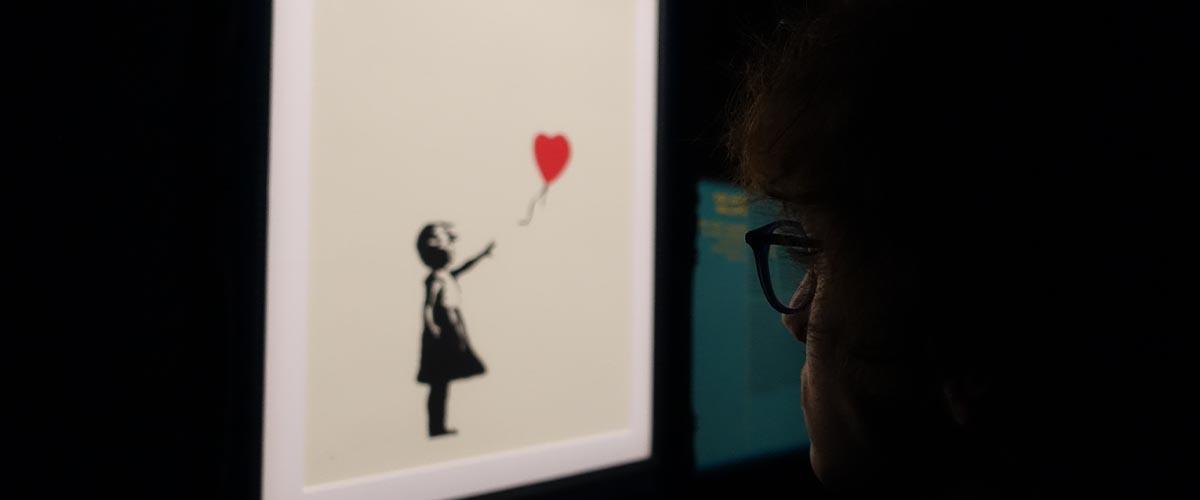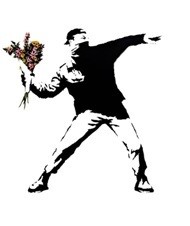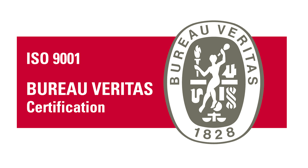記事

Trade Mark Cancelled for Bad Faith, no Flower Power for Banksy!
Who is really hiding behind the pseudonym Banksy?
Banksy, a provocative British artist and street-art icon whose real identity is still unknown, has recently paid the price for this anonymity.
A LOOK BACK AT THE FACTS...
Banksy quickly gained worldwide fame on the street-art scene, notably thanks to the famous artwork "Flower Thrower", reproduced below, depicting a masked demonstrator about to throw a bouquet of flowers, which appeared on a Jerusalem wall in 2005:

Although Banksy had for many years claimed that he would not object to the reproduction of his works, even stating "Copyright is for losers", it would appear that he has since changed his mind. In order to assert his rights and to sanction unauthorised commercial use of his works, the artist turned to trade mark law.
On 7 February 2014, a reproduction of the work "Flower Thrower" was registered as a trade mark at EUIPO by the British company Pest Control Office Limited, created to represent Banksy's interests whilst preserving his anonymity. The trade mark was duly registered by the Office under number 012575155.
Invoking its trade mark right, Pest Control Office Limited subsequently opposed the unauthorised reproduction by the British company Full Color Black Limited of Banksy's works on postcards.
In reply, the British company Full Color Black Limited challenged the validity of the right invoked. It was therefore before the EUIPO that proceedings for a declaration of invalidity of the trade mark "Flower Thrower" were brought, notably on the basis of Article 59(1)(b) EUTMR, claiming that the application had been filed in bad faith.
This ground is rarely invoked, as it is difficult to prove bad faith since there is a presumption of good faith in favour of the applicant.
However, by a decision of 14 September 2020 of the Cancellation Division of EUIPO, the Office recognized the bad faith and cancelled the trade mark "Flower Thrower".
Let’s return to the important points of this decision.
THE IMPOSSIBLE CLAIM OF COPYRIGHT
Banksy could naturally have chosen to invoke copyright law to sanction Full Color Black Limited for reproducing his works.
Indeed, any work, as long as it is original, benefits from copyright protection without any other formality. The graffiti image in question could therefore enjoy such protection.
However, an action based on copyright would have required Banksy to reveal his real identity surrender his anonymity so that he could be identified as the author of his work.
It is precisely this problem of maintaining the artist's anonymity that the EUIPO Cancellation Division raises, stating that "the fact that Banksy has chosen to be anonymous and cannot be identified would also hinder him from being able to protect any such copyrights accruing to his art (…).the evidence submitted by the applicant shows that there is a connection between Banksy and the proprietor, who would appear to be the legal representatives of Banksy, but, again, it must be noted that the evidence is not exhaustive in this regard as the identity of Banksy cannot be legally determined. All of these facts would lead to a determination that it would be quite difficult for Banksy though his representatives, the proprietor, to actually enforce copyright rights against third parties".
However, Banksy, an anonymous artist, wishes to remain so at all costs. But such anonymity comes at a price: the impossibility of claiming copyright on his works.
LATE USE OF THE TRADE MARK DID NOT HELP BANKSY
In its decision, the EUIPO notes that there is no evidence that the artist was actually marketing goods or providing services under the sign filed, either before the filing date or until the date of the application for invalidity initiated by Full Color Black Limited.
It wasn't until 2019, during the course of the proceedings, that the British artist opened an online shop and a temporary shop in London called "Gross Domestic Product" in an attempt to demonstrate the use of his trade mark.
By this commencement of use, Banksy was also seeking to avoid a possible action for cancellation for non-use of his trade mark that could be brought by Full Color Black Limited since the trade mark at issue had in the meantime become vulnerable to such an action as more than five years had passed since the date of registration.
Although this initiative was well founded, the artist, known for his "anti-system" positions, ruined his efforts to use his trade mark by making publicly stating that the use in question "was not genuine trade mark use in order to create or maintain a share of the market by commercialising goods, but only to circumvent the law".
It was playing with fire and gave EUIPO the opportunity to remind Banksy that if the trade mark confers a monopoly of exploitation on a distinctive sign, it is not without obligation from its owner!
Thus, EUIPO, using Banksy's statements, was able to characterise his bad faith: "Banksy by his own admission is clearly against intellectual property laws, but this does not mean that he is not afforded the same protection under these laws as everybody else. However, there are restrictions to the right to register a trade mark and that would be in the case where the mark is filed in bad faith”.
THE TRADE MARK DECLARED INVALID FOR BAD FAITH
Article 59 (1)(b) EUTMR on which the application for a declaration of invalidity is based provides:
"An EU trade mark shall be declared invalid on application to the Office or on the basis of a counterclaim in infringement proceedings (...) where the applicant was acting in bad faith when he filed the application for the trade mark”.
There is no legal definition of bad faith but it could be characterised as “a conduct departing from accepted principles of ethical behaviour or honest commercial and business practices” (Opinion of Advocate General Sharpston of 12/03/2009, C 529/07, Lindt Goldhase, EU:C:2009:361, § 60).
This rare decision on the concept of bad faith is an opportunity to recall the criteria to be considered when assessing the bad faith of an applicant:
- it is the filing date of the trade mark that should be taken in to account in order to assess the owner’s good faith;
- the proof is on the applicant for a declaration of invalidity to establish the circumstances from which it can be concluded that a trade mark has been filed in bad faith, the good faith of the applicant being presumed until proven otherwise;
- bad faith must be determined in relation to the objective circumstances of the case, as it is a subjective element characterising the applicant's intention at the time of filing.
In the present case, the Cancellation Division of EUIPO relied in particular on two decisive elements to qualify the bad faith: on the one hand, the sole purpose of filing the trade mark application was to acquire rights on a sign in respect of which Banksy could not claim copyright because of its anonymity and, on the other hand, Banksy had no intention at the time of filing to use the trade mark in question for the goods and services claimed. The only instances of uses were for the sole purpose of circumventing the requirements of trade mark law.
And this is what EUIPO concludes to qualify bad faith: “the contested EUTM was filed in order for Banksy to have legal rights over the sign as he could not rely on copyright rights, but that is not a function of a trade mark (...).Moreover Banksy did not have any intention to use the EUTM in relation to the contested goods and services at the time of filing of the EUTM which is the relevant time period to be taken into consideration (…). These actions are inconsistent with honest practices. They show that his intention was to obtain, without even targeting a specific third party, an exclusive right for purposes other than those falling within the functions of a trade mark (…) and thus the EUTM was filed in bad faith”.
This decision, while redefining the notion of bad faith, has the merit of reminding us that the monopoly conferred by trade mark law cannot be obtained for purposes other than those relating to the functions of the trade mark, and in particular its essential function: the identification of the origin of the goods and/or services of an undertaking.
IN PRACTICE, WHAT CAN BE LEARNED FROM THIS DECISION?
- at the date of filing of a trade mark application: there must be an intention to use the trade mark for goods or services for which protection is sought.
Although the law does not expressly stipulate such an intention, the fact of applying for registration of a trade mark without any intention to use it for the goods and/or services covered could constitute an act of bad faith from its owner since such an application would be contrary to the essential function of the trade mark.
- after a period of 5 years from the publication of its registration, the trade mark is subject to use requirement. Its owner has to use the registered sign for the goods and/or services claimed at the time of filing.
Failing this, a third party could file before the relevant IP Office a revocation action for non-use in relation with the unused goods and/or services.
The Attorneys of Plasseraud IP are available to assist you for protecting and defending your IP rights.


















